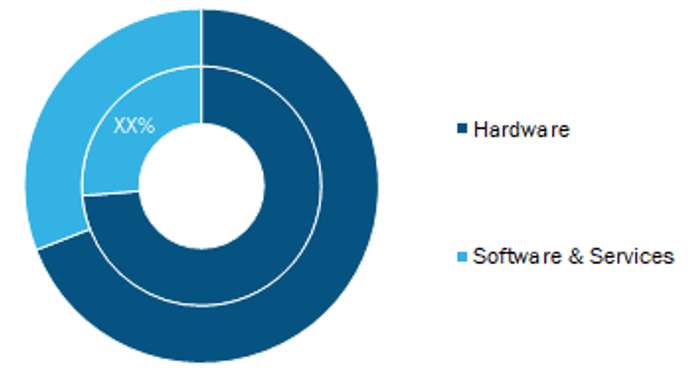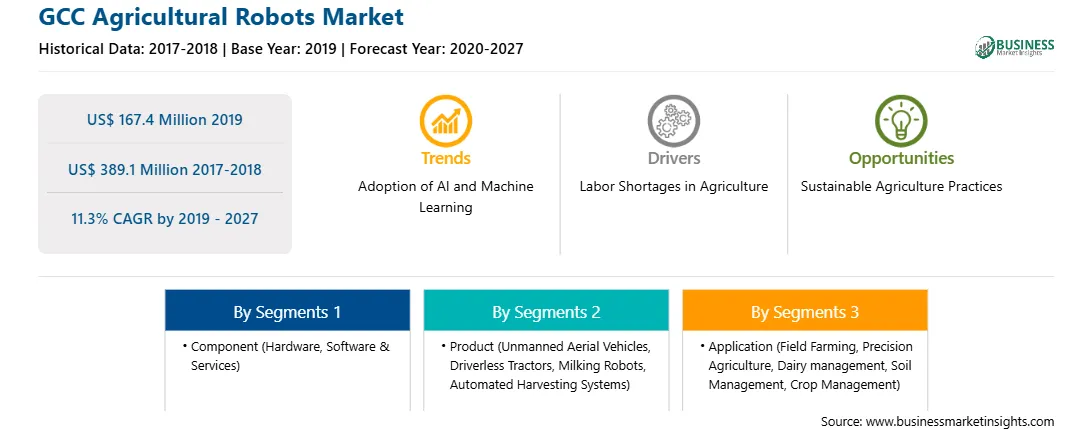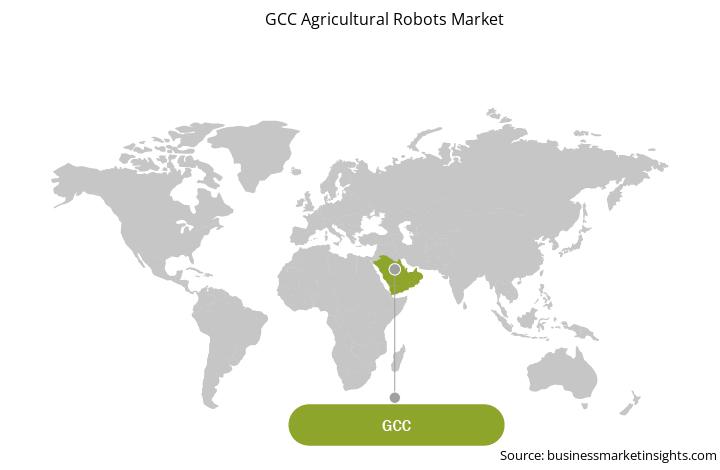The GCC agricultural robots market was valued at US$ 167.4 Mn in 2019 and is estimated to reach US$ 389.1 Mn by 2027; it is expected to grow at a CAGR of 11.3% from 2019 to 2027.
However, the market is projected to experience a dip in the growth rate during 2020 due to the impact of COVID-19 pandemic on the industry.
The growth of the IoT industry has revolutionized the agriculture industry, which depends mainly on technology, electronics, and physical and biological sciences. In addition, increasing labor prices and untrained labor have also encouraged farmers to use a cost-effective approach to improve productivity. Moreover, robotic systems with vision systems and sensors may be specially built to assess the location and ripeness of the crops that need to be harvested. This can be designed to withstand extreme environments in the world, including changing light strength, rain, wind rafts, and temperature swings. Agricultural robots are configured to ensure a minimal human interference, to speed up the farming processes. Farmers are getting used to the effective use of robots, robotic weapons, or autonomous tractors. Farmers can automate routine, sluggish, and dull tasks using such agricultural robots; this helps them to focus more on improving the overall production yield.
Impact of COVID-19 Pandemic on GCC Agricultural Robots Market
The GCC countries, including Saudi Arabia, Kuwait, Oman, Qatar, the United Arab Emirates (UAE), and Bahrain, introduced a range of precautionary steps to deter COVID-19 infection and contain the spread of the same, effective from during March 2020. Technological advancements are expected to boost the demand for agricultural robots in the GCC countries. Artificial intelligence (AI), virtual reality (VR), and augmented reality (AR) are expected to contribute significantly in adapting to the COVID-19 pandemic and solving ever-evolving challenges. Using AI can help to reduce operating costs while enhancing customer satisfaction during the renewal process and other services. VR/AR can also prove valuable in providing remote support.
Market Insights- GCC Agricultural Robots Market
Growing Population and Increasing Labor Shortage are Encouraging Automation
In over 30 years, the world population is projected to grow from 7.7 billion to 9.7 billion owing to which food consumption is predicted to increase significantly. Traditional methods, however, are not sufficient to address this upsurge. Moreover, the younger generation does not foresee farming as an attractive profession, and immigration policies across the world make it challenging to get migrant workers. Therefore, a new breed of robotic staff is being deployed in the farms, including systems ranging from UAVs to driverless cars. Agricultural robots minimize he costs incurred by farmers' wages. Moreover, humans have limited working hours, while robots can work all day, year round. Thus, agricultural robots are becoming commonplace for farmers owing to barriers caused with increasing labor shortage and growing demand for food with rising population. Further, agricultural robots contribute in many ways—economically (e.g., growing and harvesting efficiently and cost-effectively), ecologically (e.g., reducing and eliminating chemical use while ensuring soil health), and ethically (e.g., increasing animal welfare through monitoring and early intervention). Thus, the growing population and increasing labor shortage that encourage the adoption of automation are among the major factors driving the growth of GCC agricultural robots market.
Component-Based Insights–GCC Agricultural Robots Market
The GCC agricultural robots market based on components segmented into hardware, and software and services. The hardware segment led the GCC agricultural robots market in 2019.

Strategic insights for the GCC Agricultural Robots provides data-driven analysis of the industry landscape, including current trends, key players, and regional nuances. These insights offer actionable recommendations, enabling readers to differentiate themselves from competitors by identifying untapped segments or developing unique value propositions. Leveraging data analytics, these insights help industry players anticipate the market shifts, whether investors, manufacturers, or other stakeholders. A future-oriented perspective is essential, helping stakeholders anticipate market shifts and position themselves for long-term success in this dynamic region. Ultimately, effective strategic insights empower readers to make informed decisions that drive profitability and achieve their business objectives within the market.

| Report Attribute | Details |
|---|---|
| Market size in 2019 | US$ 167.4 Million |
| Market Size by 2027 | US$ 389.1 Million |
| Global CAGR (2019 - 2027) | 11.3% |
| Historical Data | 2017-2018 |
| Forecast period | 2020-2027 |
| Segments Covered |
By Component
|
| Regions and Countries Covered | GCC
|
| Market leaders and key company profiles |
The geographic scope of the GCC Agricultural Robots refers to the specific areas in which a business operates and competes. Understanding local distinctions, such as diverse consumer preferences (e.g., demand for specific plug types or battery backup durations), varying economic conditions, and regulatory environments, is crucial for tailoring strategies to specific markets. Businesses can expand their reach by identifying underserved areas or adapting their offerings to meet local demands. A clear market focus allows for more effective resource allocation, targeted marketing campaigns, and better positioning against local competitors, ultimately driving growth in those targeted areas.

Product-BasedInsights- GCC Agricultural Robots Market
On the basis of product, the GCC agriculture robots market is segmented into unmanned aerial vehicles, driverless tractors, milking robots, automated harvesting systems, and others. The milking robots segment led the GCC agricultural robots market in 2019.
Application-Based Insights- GCC Agricultural Robots Market
On the basis of application, the GCC agricultural robots market is segmented into field farming, precision agriculture, dairy management, soil management, crop management, and others. The dairy management segment led the GCC agricultural robots market in 2019.
Strategic Insights
The market players focus on new product innovations and developments to achieve sustainable growth and distinguish themselves among competitors present in the highly competitive GCC agricultural robots market.
The report segments the GCC agricultural robots market as follows:
By Component
By Product
By Application
The List of Companies - GCC Agricultural Robots
The GCC Agricultural Robots Market is valued at US$ 167.4 Million in 2019, it is projected to reach US$ 389.1 Million by 2027.
As per our report GCC Agricultural Robots Market, the market size is valued at US$ 167.4 Million in 2019, projecting it to reach US$ 389.1 Million by 2027. This translates to a CAGR of approximately 11.3% during the forecast period.
The GCC Agricultural Robots Market report typically cover these key segments-
The historic period, base year, and forecast period can vary slightly depending on the specific market research report. However, for the GCC Agricultural Robots Market report:
The GCC Agricultural Robots Market is populated by several key players, each contributing to its growth and innovation. Some of the major players include:
The GCC Agricultural Robots Market report is valuable for diverse stakeholders, including:
Essentially, anyone involved in or considering involvement in the GCC Agricultural Robots Market value chain can benefit from the information contained in a comprehensive market report.